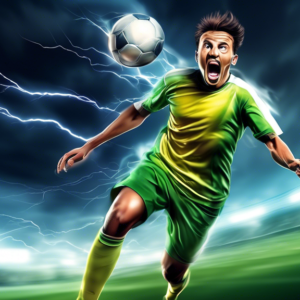Introduction
In the lightning-fast world of soccer, reaction time can be the difference
between a spectacular save and a goal conceded, a pinpoint pass and an
interception, or a perfectly timed tackle and a yellow card. It’s a crucial
aspect of the game that often separates the amateurs from the pros.
This article delves into the importance of reaction time for soccer players
and provides a comprehensive guide to enhancing it through effective drills
and training methods. Whether you’re a goalkeeper facing a penalty kick or a
striker anticipating a cross, improving your reaction time can significantly
impact your overall performance.
Understanding Reaction Time in Soccer
Reaction time refers to the speed at which a player responds to a stimulus.
In soccer, these stimuli are countless and ever-changing, including:
- A change in the direction of the ball
- An opponent’s movement
- A teammate’s call
- The referee’s whistle
A fast reaction time allows players to make split-second decisions and
execute actions efficiently. This translates into:
-
Goalkeepers: Making crucial saves, reacting to shots,
and intercepting crosses. -
Defenders: Tackling effectively, blocking shots, and
closing down attackers. -
Midfielders: Intercepting passes, transitioning play
quickly, and finding open teammates. -
Forwards: Timing runs perfectly, finishing scoring
opportunities, and creating space.
Factors Affecting Reaction Time
Several factors influence a player’s reaction time, and understanding these
factors is key to developing targeted training:
1. Age
Reaction time peaks in early adulthood and gradually declines with age.
However, regular training can help mitigate this decline.
2. Genetics
Genetics play a role in determining baseline reaction time. Some individuals
naturally possess faster reflexes than others.
3. Fitness Level
Improved fitness levels, particularly cardiovascular endurance and muscular
strength, contribute to faster reaction times.
4. Focus and Concentration
A player’s ability to maintain focus and concentrate on the game directly
impacts reaction time. Distractions can delay responses.
5. Experience and Anticipation
Experienced players develop a better understanding of the game, enabling
them to anticipate actions and react more quickly.
Reaction Time Drills for Soccer Players
Incorporating specific drills into training sessions can significantly
enhance a player’s reaction time. Here are some effective exercises:
1. Ball Drop Test
Equipment: A tennis ball or a small soccer ball
Instructions:
- Have a partner hold the ball at shoulder height.
- Stand facing the partner with your arms extended forward.
-
As soon as the partner drops the ball, try to catch it as quickly as
possible. - Vary the height and release point of the ball for added difficulty.
2. Light Board Drills
Equipment: A light board or an app that simulates one
Instructions:
- Stand facing the light board.
- As random lights illuminate, touch or tap them as quickly as possible.
-
Adjust the difficulty by increasing the number of lights or decreasing the
illumination time.
3. Cone Taps
Equipment: Cones of different colors
Instructions:
- Set up cones of various colors in a random pattern.
-
Have a partner call out a color or a sequence of colors, and tap the
corresponding cones as quickly as possible. -
Increase the complexity by incorporating movements like sprints or
shuffles between cone taps.
4. Reaction Balls
Equipment: Reaction balls (irregularly shaped balls)
Instructions:
-
Have a partner throw or bounce the reaction ball, and try to catch or trap
it as it bounces unpredictably. - Focus on reacting to the ball’s movement rather than predicting it.
5. Small-Sided Games
Equipment: Regular soccer equipment
Instructions:
- Play small-sided games like 3v3 or 4v4 in a confined space.
-
The emphasis should be on quick decision-making, rapid passing, and
reacting to the game’s flow.
Tips for Improving Reaction Time
In addition to specific drills, consider these tips to enhance your reaction time:
-
Get Enough Sleep: Aim for 7-9 hours of quality sleep
each night to allow your body and mind to recover and function optimally. -
Eat a Healthy Diet: Consume a balanced diet rich in
fruits, vegetables, lean proteins, and whole grains to provide your body
with the necessary nutrients for cognitive function. -
Stay Hydrated: Dehydration can impair cognitive
performance, including reaction time. Drink plenty of water throughout the
day, especially before, during, and after training sessions. -
Warm Up Properly: Always begin training sessions with a
thorough warm-up to prepare your muscles and nervous system for activity. -
Incorporate Plyometrics: Plyometric exercises, such as
box jumps and jump squats, help develop explosive power and improve
reaction time. -
Visualize Game Situations: Mental imagery can be a
powerful tool for improving reaction time. Visualize yourself reacting
quickly to various game situations to enhance your preparedness. -
Get Enough Rest: Allow for adequate rest and recovery
between training sessions to prevent burnout and maximize your body’s
adaptation. -
Be Patient and Consistent: Improving reaction time takes
time and effort. Be patient with your progress and maintain consistency
with your training.
Conclusion
Enhancing reaction time is an ongoing process that requires dedication and
consistent effort. Incorporating the drills and tips outlined in this article
into your training regimen can significantly improve your ability to react
quickly and decisively on the soccer field. Remember that even small
improvements in reaction time can make a substantial difference in your
overall performance.
